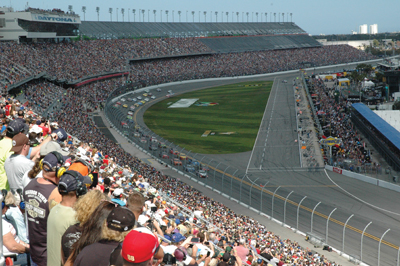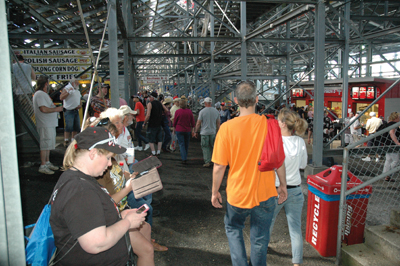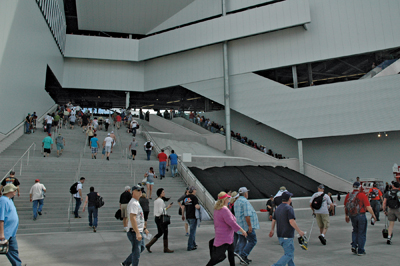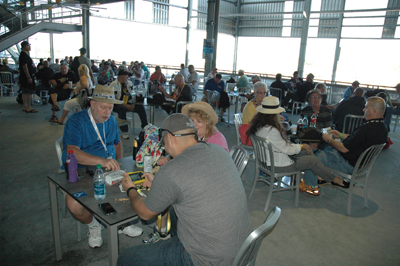Joie Chitwood was roaming the spacious new concourses at Daytona International Speedway’s open house a few days before the Daytona 500 when a woman holding race tickets approached him.
“When are you going to re-do my section?” the woman asked him. “I’m sitting in the old part and we don’t have any of this stuff.”
 |
A view from the Daytona grandstands shows empty sections where work remains to be done as part of the Daytona Rising project.
Photo by: DON MURET / STAFF
|
“We’re going to get to it,” assured Chitwood, the track’s president, referencing the three-year project’s scheduled completion next January.
“But I want that now!” she said.
The exchange between the NASCAR die-hard and Chitwood, International Speedway Corp.’s front man for the $400 million Daytona Rising renovation, was a testament to the desperate need for the improvements at the 56-year-old property. The project sets a new benchmark for tracks at the sport’s highest level, and come this time next year, the updated facility will match the stature and prominence of the Daytona 500, considered the Super Bowl of stock car racing.
Fans who sat in the older sections for this year’s race will no longer have to maneuver narrow walkways on rough patches of blacktop, and sit on steel support beams to eat their pre-race meal.
“There were no places to sit down before,” said Rishi Nigam, vice president of food and beverage for Americrown, International Speedway Corp.’s food provider at Daytona. Nigam said. “When people have the opportunity to sit down and enjoy their meal, they’re more likely to pay a little more money and you can also serve better food.”
Those patrons should also find it easier to identify their seats in more clearly marked sections, Chitwood said. And those walking the new covered concourses will no longer be subject to the “race juice” raining down from fans spilling their beers on unsuspecting victims below, said Derek Muldowney, an ISC executive vice president principally involved in the renovation.
New and wider chairback seats, permanent food stands and bars, restrooms with high-speed hand dryers, dining spaces filled with tables and chairs, and a dedicated service level are basic amenities in arenas and stadiums, design features that big league teams take for granted. Those elements, though, have been lacking at racetracks holding NASCAR events, including at Daytona, the sport’s signature facility.
Chitwood recognized Daytona’s deficiencies and got buy-in from the France family, ISC’s owners and founder of NASCAR, to make the hefty investment for a major overhaul of the facility.
After the project was approved, most of it funded with private money, Chitwood and Muldowney researched stadiums worldwide, including NFL and European soccer venues, to get a better sense of what it would take to elevate Daytona’s fan experience.
“We’re different in that we don’t have the frequency of use that other stadiums have, and that’s a big challenge,” Muldowney said. “We can’t build a $2 billion stadium. We have to try and balance the level of amenities for fans against cost.”
 |
Old sections (above) will soon be replaced by concourses with spaces to sit and eat near concession stands.
Photos by: DON MURET / STAFF (2)
|
Working closely with sports architect Rossetti and general contractor Barton Malow, ISC developed a three-year plan to renovate a track about 50 percent bigger than an NFL stadium for 25 percent of the cost, Muldowney said.
“We keep reminding people of that,” he said. “It’s not [the] Cowboys’ stadium or [the] Giants’ stadium. We try to maximize bang for the buck.”
The track’s five “injectors,” the term officials use to describe the structures holding escalators
transporting fans to and from the track’s newer portions, are modeled after MetLife Stadium’s four cornerstone destinations, spaces branded for top sponsors.
At Daytona, Florida Hospital and Toyota signed deals to sponsor two of the five injectors and plan to activate those spaces for next year’s 500. A third agreement is expected to be announced in the next 60 days, Chitwood said.
“The injector concept in my mind is the genius behind this whole project because it was never going to be [track] naming rights at Daytona,” Muldowney said. “One of the things that caught our interest was what MetLife did … and how we could use that concept and make it work here.”
ISC brass also knew the sport’s corporate hospitality structure was outdated. Sponsors entertain guests in tents outside the track before races, but often lose touch with those clients and potential customers as they disperse into the massive grandstand for the start of the event.
“We could see that model was not going to sustain itself,” Muldowney said. “People bring customers to these events because they want to engage and do business with them. You want to entertain clients over the four to five hours that this event is going on and you can’t do that in a tent.”
Next year there will be no tent village. The project’s final phase will include two new premium-seat products at mid level along the front stretch with the flexibility to accommodate groups of 50 to 500 people.
 |
Daytona has signed sponsor deals for two of the new “injector” entry points.
Photo by: DON MURET / STAFF
|
The 31 high-bank suites have interior space and an outdoor patio with seats in front of those areas. The 25 midway suites have no view to the track, but those guests have tickets for seats on the 400 level, the top floor of the new grandstand providing some of the best sight lines.
“This was a big deal for us,” Chitwood said. “For the VIPs and C-level executives, if you’re justifying your budget spend to [brand] a race car in NASCAR, you must have the right options to entertain, and a tent isn’t really the experience anymore.”
As ISC nears the finish line of Daytona Rising, the group will turn its attention to upgrading its 11 other properties, including newer tracks such as Chicagoland Speedway and Kansas Speedway. Both venues are entering their 15th season of operation.
“We’ll go through the same exercise we went through for Daytona to identify deficiencies,” Muldowney said. “We have a long-term plan to bring a different version of Daytona to most of the other facilities over time. You’ve got to keep current. We’re in the entertainment business.”







